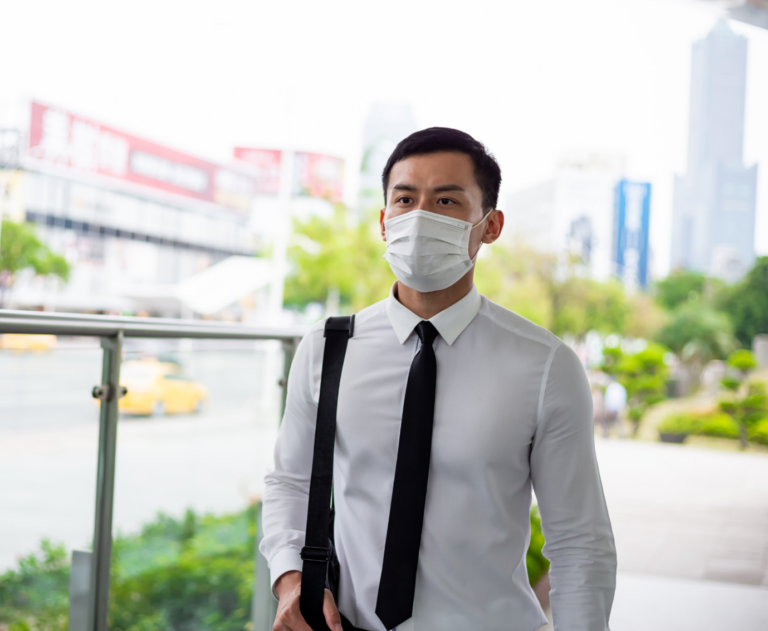Today, the World Health Organisation (WHO) suggests wearing face masks work as a normal part of being around other people and says that they should be used as part of a comprehensive strategy of measures to suppress transmission and save lives, while acknowledging that face mask use alone is not sufficient in providing complete protection against COVID-19.
Physical distancing and the use of face masks are widely agreed to be the most effective ways of preventing short-range COVID transmission. According to Prof Jonathan Reid, director of the University of Bristol’s Aerosol Research Centre the greatest risk of exposure is when you’re close to someone, as the COVID-19 virus loses 90% of its potential within 20 minutes of being airborne, with most of the loss occurring within the first five minutes. When you stand too closely to someone not wearing a face mask, the risk of exposure is highest; however, as you move further away, not only is the aerosol diluted, there’s also a less infectious virus since it has lost its infectivity [because of time].
According to Dr. Stephen Griffin, associate professor of virology at the University of Leeds, if there isn’t proper ventilation, the virus can quickly fill up interior areas, and if the infected individual remains in the room, the viral levels can get replenished. According to Dr. Julian Tang, a clinical virologist at the University of Leicester, masks are quite effective in preventing transmission if people cannot physically distance themselves, and improved ventilation also helps if it is close to the source.
What does the evidence say?
The US Navy reported a COVID-19 outbreak aboard an aircraft carrier in early 2020, with 382 service members in close quarters. The use of face masks was found to lower each member’s chance of developing COVID-19 by 70%.
A large, randomised experiment by researchers at Stanford Medicine and Yale University found that wearing a surgical face mask over the mouth and nose is an effective strategy to prevent the recurrence of COVID-19 in community settings.
A study published in Royal Society Open Science, measured droplets spread by participants coughing and speaking while wearing surgical or homemade cotton face masks. According to the researchers, a person standing 2 metres away from someone coughing without a mask is exposed to more than 10,000 times more respiratory droplets than someone standing 0.5 metres away using a simple single-layer mask.
Another study in China discovered that face masks work best when used by both the patient and other residents, reducing transmission throughout the household by 79 percent in 124 families, where there had been a laboratory-confirmed coronavirus infection.
What Type of Mask Should I Wear?
Put simply, wearing a face mask that is both comfortable and fits firmly around your face, covering both the nose and mouth, whether it be surgical, cloth, or a medical respirator, is the first step in protecting yourself. It’s also important to remember that masks are not a substitute for other precautions that prevent the spread of COVID-19 including; getting tested, staying home when unwell, social distancing, and hand hygiene.
N95/P2 Masks
N95/P2 masks significantly reduce the spread of viral infections. When correctly fitted, these face masks work by sealing tightly around the face and filtering out very fine particles, helping to protect against droplet and airborne transmission. Some experts say that medical respirators, (N95 or P2 masks), are the best masks for preventing the transmission of the COVID-19 Omicron variant, while acknowledging that they are more expensive and can be challenging to wear.
Surgical Masks
Surgical face masks work by stopping respiratory droplets from other people entering your mouth and nose. They are suitable for medical use and are intended to be thrown away after wearing. You’ll find that surgical masks are usually blue on the outside and white on the inside and are sold as Level 1, 2, or 3 with increasing degrees of protection. Researchers from Stanford and Yale discovered that surgical masks are 95 percent efficient in filtering out COVID-19 virus particles, compared to only 37 percent for cloth masks.
Cloth Masks
Sustainability wise, cloth masks are undoubtedly preferable as they’re washable and reusable, however their quality and effectiveness are unregulated. They work to stop the wearer from inhaling droplets from others and to stop respiratory droplets from being released when the wearer breathes, talks, coughs, or sneezes.
The whole idea of wearing masks is risk reduction. For example, many people with COVID-19 have mild or no symptoms and can be infectious without realising. In these circumstances, wearing a face mask significantly reduces the risk of transmission to others.
Social Distancing and Masks
There are a few things we’ve been told over and over by health authorities that we need to do to protect ourselves from COVID-19; wash our hands, sanitise, wear a face mask, avoid crowded places, and maintain social distance. What the evidence above shows is that transmission is highest through inhaled droplets, which makes wearing a mask the #1 most important of these tips. Remaining socially distanced while also wearing a mask gives you that extra level of protection. And of course, keep those hands clean!
You can browse our range of face masks, signage, hand sanitisers etc at www.cos.net.au
No products were found with the applied settings

